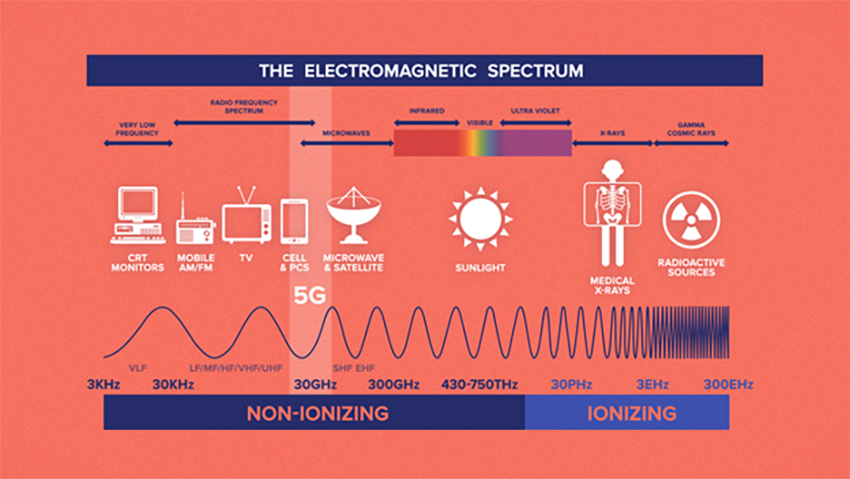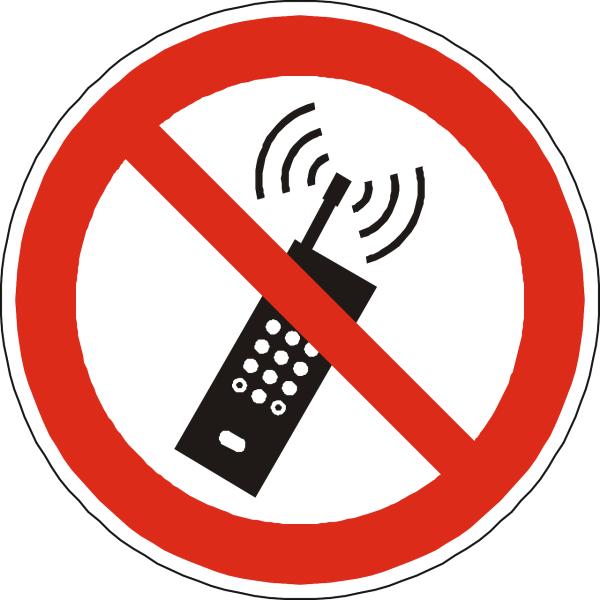The Environmental Working Group (EWG) is a non-profit with an agenda to shine “a spotlight on outdated legislation, harmful agricultural practices, and industry loopholes.” Like others in the scientific “scare space,” they believe that BIG government regulations are evil, biased by BIG business; their equally biased special interest regulations are “better.” Their latest white paper consists of guidelines for radiofrequency radiation, done by their staff, accepted by a peer-reviewed journal based on a study done by the US Dept. of Health and Human Service’s (DHHS) National Toxicology Program. [1]
I have asked two of our scientific advisors Dr. Karam and Susan Goldhaber, to comment on the EWG report, which we will do in a four-part series over the next week. Before I turn the discussion over to our two experts, let me lay some groundwork.
Two federal agencies share regulatory responsibility for cellphones. The FCC determines the radiofrequency energy used by cellphones and other cellular devices. The FDA defines the safety of these emitters and provides this information to the public.
Cellphone Fears
“The most consistent health risk associated with cell phone use is distracted driving and vehicle accidents.”
Concerns have been raised about the radiation emanating from cell phones almost since their inception; after all, cell phone use and wireless devices are everywhere. The word radiation carries a lot of emotional baggage, but in this instance, the radiation is at the low energy portion of the spectrum – radiofrequency radiation that
 has little power to penetrate anything, including our tissue. And even when it does penetrate, its most common effect is thermal, raising the local temperature. It is not like ionizing, high-energy radiation from X-rays, penetrating tissue more deeply and breaking DNA bonds. Despite the lack of a direct means of causing cell mutation, there has been a recurring concern about cellphones causing cancer – specifically those in the head and neck, the places we most commonly hold cellphones.
has little power to penetrate anything, including our tissue. And even when it does penetrate, its most common effect is thermal, raising the local temperature. It is not like ionizing, high-energy radiation from X-rays, penetrating tissue more deeply and breaking DNA bonds. Despite the lack of a direct means of causing cell mutation, there has been a recurring concern about cellphones causing cancer – specifically those in the head and neck, the places we most commonly hold cellphones.
If these wireless devices cause cancers, why have decades of studies demonstrated stable rates of brain tumors among adults and children while cellphone use has exploded exponentially?
Can cellphones cause cancer?
As you might expect, the answer is both complicated and uncertain. Dr. Geoffrey Kabat, a cancer epidemiologist, has written in the past that
“… it is not possible to prove that an exposure is safe. What risk assessment agencies typically do is to use animal – and, where available, human data — to determine a level below which no adverse effects were observed and then to add a safety margin of one-hundred or one-thousand. This approach has been used successfully for decades.”
EWG feels it is time for a reassessment and that the current levels should be reduced many-fold. Their analysis makes use of the NTP findings. But we believe that the underlying study is flawed because it uses whole-body radiofrequency radiation that does not reflect real-world usage. Interpreting scientific results is often in the eye of the beholder. The FDA, in commenting on the NTP study underlying the EWG report stated:
“Animal studies like this one contribute to our discussions on this topic, but we must remember the study was not designed to test the safety of cell phone use in humans, so we cannot draw conclusions about the risks of cell phone use from it.”
Yet, that is what the EWG did.
The NTP Study
The study found several Schwann cell tumors in the hearts of male but not female rats who received total body radiofrequency radiation for 9 hours a day for two years – roughly 75 times greater than the radiofrequency radiation limits already in place. [2] Tumors of the heart are rare in humans, Schwann cell tumors even rarer; the medical literature reports only 17 cases. As the researchers noted at the time of their press release
"The levels and duration of exposure to RFR were much greater than what people experience with even the highest level of cell phone use and exposed the rodents’ whole bodies. So, these findings should not be directly extrapolated to human cell phone usage." [Emphasis added]
Many experts have disagreed with their view. The NTP’s peer review felt that there was clear evidence of an effect on male rats. In fairness, Schwann cell tumors are similar to cells found in areas of the brain associated with cellphone-linked tumors, i.e., acoustic neuromas and gliomas.
IARC
It wouldn’t be a health concern if the International Agency for Research on Cancer (IARC) didn’t chime in; after all, they identified coffee, hot water, and pickled vegetables as possibly carcinogenic. In 2011, IARC classified radiofrequency electromagnetic fields as “possibly carcinogenic to humans,” based on an increased risk for glioma - a malignant type of brain cancer associated with wireless phone use. This classification was based on limited evidence in humans and animals, but IARC felt there was enough evidence to consider it “possibly carcinogenic.”
Interphone Case-Control Study
This was the most extensive case-control study of cell phone use conducted over 13 countries and involved participant self-reporting. The reported outcomes varied. While most studies demonstrated no aggregate gliomas or meningiomas, one study showed a small increased risk of gliomas in those using the highest amount of cell phone time. Similarly, there was no consistent association between cell phones and tumor location.
Danish Cohort Study
This study utilized billing data of about 360,000 phones as a marker of cellphone use along with data in the Danish Cancer Registry. They could not identify an association between cellphone use and neurologic tumors.
Million Women Cohort Study
This prospective study in the UK involved self-reported cellphone use. Again, there was no association with neural tumors. An early finding of an association with acoustic neuromas lost statistical significance as additional years of cellphone use accrued.
The Children
EWG also voiced concerns about the effect of radiofrequency radiation on our children. Children are not small adults; they have different body ratios. For instance, their heads are smaller, making for possibly different effects of penetrating rays, so radiofrequency studies in children are essential.
It has been estimated that more than 50% of children over the age of 10 have a cellphone. And they spend two hours or more a day on those devices. But as any parent will tell you, they are not making phone calls with the phone to their head. They are scrolling and looking at social media, which puts the cellphone’s radiation much further away, making it less able to penetrate the distance to, let alone into, their bodies.
The Battle Lines Are Drawn
“Indeed, big wireless has borrowed the very same strategy and tactics big tobacco and big oil pioneered to deceive the public about the risks of smoking and climate change, respectively. And like their tobacco and oil counterparts, wireless industry CEOs lied to the public even after their own scientists privately warned that their products could be dangerous, especially to children.”
The fight over the safety of cellphone radiation mirrors similar skirmishes over tobacco, chemicals, and our all- too-human behavior.
- Distrust of authority, both scientists and public health officials, in and out of government.
- As reported by the NY Times, outside agencies, i.e., Russian propaganda, has fostered discontent with articles on the harm on 5G networks
- Accusations by both sides of cherry-picking findings from studies that support their views while ignoring other research
- Appending the name Big to the wireless communication industry to suggest a monolithic, evil force.
For this series, we will consider
- how cell phone “radiation” affects the body - Radiofrequency Radiation And Cancer
- the impact of experimental design on a study and its applicability to humans
- how the data from these studies are analyzed and interpreted
These will help you to better understand the EWG study, as well as why it should be taken with a “grain of salt.”
[1] All authors are employed by EWG and report no competing interests. Funding is from the Jonas Philanthropies – “A four-year grant from Jonas Philanthropies will fund The Jonas Initiative at EWG, which aims to become the premier online source of information for parents searching for credible, science-based, actionable information about the impact of toxic chemicals, contaminants and toxics on children’s health.” So much for transparency
[2] The specific absorption rate (SAR) measures “the relative amount of RF energy absorbed in the head of a user of a wireless handset. The FCC limit for public exposure from cellular telephones is a SAR level of 1.6 watts per kilogram (1.6 W/kg).”
The Series
Part I – Do Cell Phones Cause Cancer
Part II – Radiofrequency Radiation and Cancer
Part III - Experimental Design (or why rats are not people – among other things)
Part IV - Do 5.3 billion Cell Phone Users Need to Worry?
Sources: Is 5G making you sick? Probably not CNET
Scientific Evidence for Cell Phone Safety Food and Drug Administration
The inconvenient truth about cancer and mobile phones The Guardian
Cell Phones and Cancer Risk National Cancer Institute




